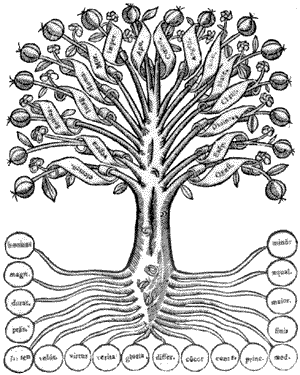weltlos, sem-mundo, worldless, carente de mundo
El Dasein no es el sujeto aislado y cortado del mundo (weltlos) del idealismo tradicional. Existe en el mundo, y su ser está hecho fundamentalmente por el comercio que mantiene con este último, con esta exterioridad que la temporalidad segrega. El mundo y sus objetos están, por consiguiente, íntima e inexorablemente ligados al devenir histórico del Dasein. (Waelhens)
Al mundo pertenece la naturaleza. Pero ¿tiene mundo la naturaleza distinta del hombre? La piedra, el animal, ¿tienen un mundo, o se dan solamente allí? ¿Qué tipo de relación guarda el hombre con las cosas y esencias que comparecen ante él? La piedra es carente de mundo (weltlos). Aparece en el mundo sin que de suyo pueda establecer una relación con él. El animal es pobre en mundo (weltarm); su mundo y reducido radio de acción se limitan a lo que Heidegger denomina un «anillo entorno». El animal reacciona a los estímulos que de allí proceden y responde con ciertos mecanismos comportamentales. El animal tiene una determinada apertura para el mundo, pero el mundo no puede revelársele como tal. El animal tiene cierto acceso al mundo y exhibe un tipo de conducta (Benehmen) con respecto a este. El animal percibe cosas y ofrece respuestas inteligentes a su entorno (Umgebung), pero no comprende qué hay, qué significa existir (cf. GA29-30: 290-292). El animal, por tanto, no dispone de la posibilidad de relacionarse y comprenderse a sí mismo como estar-en-el-mundo. No carece de mundo como los minerales, pero tampoco tiene la capacidad humana de constituir y configurar mundo. (Escudero)
VIDE: weltlos
sans-monde
worldless
NT: Worldless (weltlos), 55, 110-111, 188, 192, 206, 211, 316, 366, 388 (BT)
Although philosophers are quick to conclude that what distinguishes human beings from other kinds of being is that we are not just natural objects, but knowing subjects, Heidegger claims that a more fundamental difference, and one universally overlooked by philosophers, is the way that Dasein inhabits a world (Welt). For that reason, Heidegger uses the term “being-in-the-world” to designate the basic ontological constitution of Dasein. To be precise about what distinguishes Dasein from other beings, we first need to recognize the difference between the way something is objectively present in space, like a desk in a room, and the way we inhabit our environment (Umwelt). In Heidegger’s view, a piece of furniture is “inner-worldly” (innerweltlich), or objectively present in the world, but essentially “worldless” (weltlos), or indifferent to other beings. We, on the other hand, are “worldly” (weltlich) in the sense that our existence is defined by our worldly concerns, our dealings with the things we encounter in the world, and our disclosure of the context in which they have meaning to us. On the one hand, we are ontologically distinct from the objects surrounding us, which we understand in terms of our own possibilities, but on the other hand, we are nothing like an isolated, worldless subject of the sort that philosophers have traditionally identified with the acquisition of knowledge. For such a subject is commonly understood as something no less objectively present—as a peculiar sort of thing with its own distinctive properties—than the objects of nature. Yet, Heidegger says, “Dasein understands itself ontologically—and that means also its being-in-the-world—initially in terms of those beings and their being which it itself is not, but which it encounters ‘within’ its world” (BT 58-59/58). For Heidegger, being-in-the-world is a phenomenal unity prior to the very distinction between subject and object, (101) which is at the root of the problem of knowledge. As a perceiver and a knower, he argues, “Dasein does not first go outside of the inner sphere in which it is initially encapsulated, but, rather, in its primary kind of being, it is always already ‘outside’ together with some being encountered in the world already discovered” (BT 62/62). Heidegger initially clarifies this in terms of the being of the objects that we encounter in our everyday dealings, the “readiness-to-hand” or “handiness” (Zuhandenbeit) of useful things, but he ultimately explains it on the basis of temporality as an original “outside of itself” in the directions of the future, past, and present. (MasseyOT)
